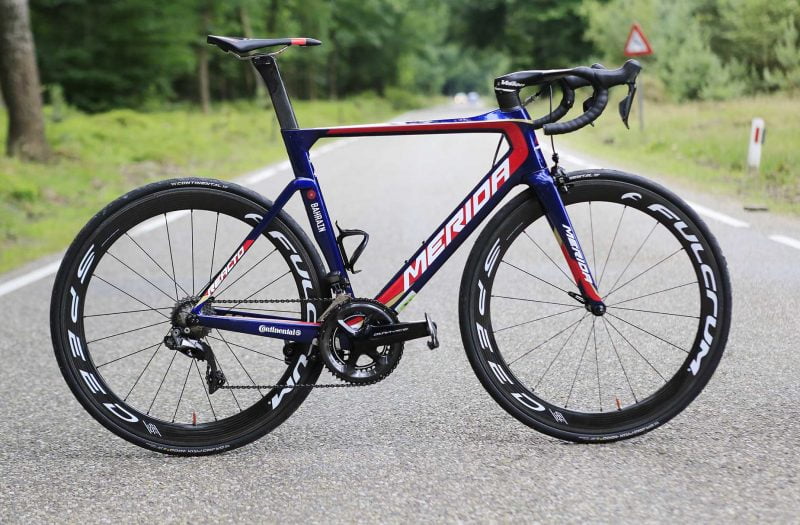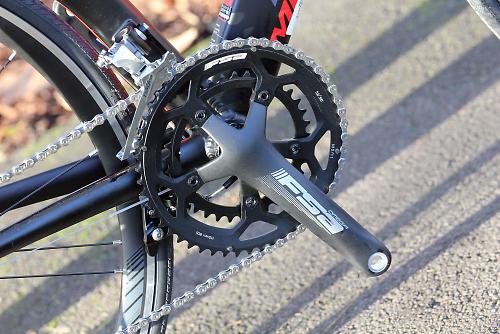Merida Reacto 300 2018
Merida Reacto 5000 is a performance oriented aero road bike, best suited to road riders or triathletes looking to take their riding or racing to the next level. For those who follow the Pro Tour, the Reacto was the bike of choice for the majority of Team Bahrain Merida for most of the the Tour De France this year. Reacto disc 5000. Scultura disc 4000. Scultura disc 400. Scultura disc 200.
For 2018, Merida has just announced the third iteration of this well-rounded aero road bike, the Reacto III. Improving on the previous version that earned praise thanks to its wind tunnel test results and ability to smooth out rough roads, the Reacto III looks set to keep up with the fast developing market. It's a bike that will be seen in use with Bahrain Merida’s Tour de France debut. Here are ten things to know.
Not sure if an aero road bike is right for you? Watch and read our guide to how Aero road bikes stack up against traditional race and endurance road bikes.
1. Similar profile to the last
From a distance, the new Reacto looks much like its predecessor (unless you’re looking at the disc version!), and that’s because in many ways it is. The sculpted seattube and lowly-set seatstays remain, as does the deep aero S-Flex seatpost. Likewise, Merida sticks with its NACA Fastback profiles on many of the frame’s tubes for cheating the wind.
However, take a closer look at some subtle exterior differences appear. The downtube shape is slimmer, the seatstay connection is lower and obviously, there’s that one-piece cockpit setup too. All told, Merida claims a 5% improvement in aerodynamics compared to the previous Reacto.


2. Two frame levels, two geometries
The new Reacto is available in two levels of frame, the premium CF4 and the CF2, each with differing geometry.
Sitting as the top-end option, the CF4 frame uses a premium carbon fiber layup and hosts a number of subtle features that help it to be a little faster. Most notably, the CF4 frame features a more aggressive geometry that’s well suited to the racers. In fact, the stack height is lower and the head angle steeper when compared to the previous Reacto. The bottom bracket height has been dropped 5mm too.
The more affordable Reacto bikes make use of the CF2 frame, something that’s a little heavier and also features a more relaxed geometry when compared to the CF4. Here, the head tube angles are relaxed by half a degree, the stack sits over 20mm higher and the reach is also subtly shorter.
3. Lighter, faster, smoother
It wouldn’t be the bike industry without such claims, and Merida certainly hasn’t disappointed in improving the most obvious metrics.
While frame stiffness is said to be kept the same as the previous version, the weight is drastically different, 18.5% less for the entire frameset in fact. Including frame, fork, headset, seatpost and seatpost clamp, the previous Reacto weighed 2,046g, with the new at 1,695g.
Looking at the specifics (sizes unknown), the new CF4 rim brake frame and fork together weigh a claimed 1,368g. The CF4 Disc version adds just 60g to the figure.
Featuring a few subtle differences, namely a cheaper carbon fibre lay-up, the CF2 rim brake frame and fork weigh a claimed 1,500g together, with the disc brake version adding 97g.
The weight loss, achieved through slimmer tubes and a new carbon layup, hasn’t come at the cost of ride comfort. With the lower set seatstays and an updated seatpost said to provide a bike that’s approximately 10% smoother.
4. Disc and rim brake options
It seems fewer and fewer road racing bikes are being released without a disc-brake option, and the new Reacto is no exception. While all models will remain available with a direct-mount rim brake option, a large number of models will also be available in a disc-brake version (disc versions are sadly not being brought into Australia).
The disc brake versions feature flat-mount calipers, 12mm thru-axles and 160mm rotors front and rear.
5. Borrowed from the Scultura Disc
First seen with last year’s Merida Scultura Disc road bike, the Reacto Disc makes use of the same clever disc cooling system. These aluminium fins that sit on the fork and left chainstay help direct air into the brake calipers and rotors, and are said to reduce temperatures by around 35%.
6. Tricky Thu-Axles for the Disc
Where the rim brake versions stick with tried-and-trued quick releases, the disc versions make use of 12mm thru-axles front and rear. Interestingly, the CF4-level bikes receive the fast ‘R.A.T’ system, something designed to aid speedy wheel changes in a race situation.
Merida Reacto Review

This ‘Rapid Axle Technology’ (R.A.T) system was originally conceived by Focus Bikes and offers a clever keyed system that requires a flick of the quick lever and then quarter turn to undo, not the full unwinding of a more common threaded thru-axle system (something the CF2 Disc bikes make use of).
7. Tire clearance
Tires are forever getting wider as research has proven narrower isn’t always faster. Where some bikes are touting space for 28 or even 30c tires, Merida has kept the new Reacto a little more conservative and promises easy fitting of 25c tires on both the rim and disc-equipped versions.
8. Integrated cockpit
Integrated cockpits have become a popular pick on the latest aero road bikes, and smoothing out the front of the bike just makes sense when looking to fully optimize aerodynamics.
Where we’ve seen brands such as Trek, Specialized, Canyon and others go to the efforts of designing such an integrated handlebar and stem in-house, Merida instead reached out to a long-time component partner to refine a proven product.
As a result, the CF4-level Reactos will feature a one-piece carbon handlebar and stem that’s a close match to FSA’s Metron 5D. A special headset cone spacer has been supplied for a smooth, integrated fit with this cockpit setup.
The CF2 bikes will stick with a more traditional stem and handlebar, as is often the case on more affordable aero road bikes.
9. S-Flex seatpost gets better

Merida’s comfort adding S-Flex seatpost that features a flexible design and a small vibration-dampening rubber insert gets a small makeover. The design has been in use since 2012 and for 2018 will offer more comfort at a lower weight (94g saved).
The CF4-level bikes will feature a 206g fixed-offset version, while the cheaper CF2 framed bikes will use a flip-able head design that offers 0-15mm fore-aft saddle adjustment.
The seatposts are interchangeable between frames and Merida will offer the lighter fixed seatpost in either 15 or 25mm offset versions.
Merida Reacto 300 2018 Models
Follow BikeExchange: Email | Facebook | Twitter | Instagram | YouTube | STRAVAIt was only a matter of time before we got around to featuring Merida in our 2018 bike guide. The brand, often mistaken for a Spanish marque given its Hispanic name, in fact calls Taiwan home (with links to Germany), just like Giant. In fact, Merida, like Giant, is also one of the few bike brands that owns its own manufacturing processes.
So what’s on offer? Well, the top-line race bike you’ll spot under riders of the Bahrain-Merida team most of the time is the Reacto, the aero race machine that received an update ahead of the 2017 Tour de France.
It boasted a claimed five per cent improvement in aero efficiency, while compliance was also said to be improved by ten per cent. What’s interesting, however, is that along with being available in both rim and disc brake guises, you can also have it in the pro-level CF4 layout, or the slightly pared-back and relaxed CF2 geometry, potentially making it an aero bike for the masses. There’s also an alloy version of the Reacto in the mix, too.
On the other side of the race coin is the Scultura, which is every bit a race bike as the Reacto, but caters to the needs of the lightweight climbers. Therefore, it’s generally Vincenzo Nibali’s bike of choice – it’s won a Giro d’Italia stage and Il Lombardia underneath the Shark of Messina this year – and also boasts good levels of compliance too, as we discovered when we rode the disc-equipped version over the cobbles of Paris-Roubaix. This predominately carbon-framed range is bolstered with eight aluminium models.

In terms of alloy bikes, there’s also the Race line-up, with two builds that offer a more affordable entry point to the Merida brand, while the emerging gravel market is catered for with the Silex – two carbon and five aluminium models here – and there are no bonus points for guessing what the Cyclo Cross bikes are designed for. Finally, the time trial artists among you might consider the Warp TT steed.
Merida Reacto 300 2018 Reviews
Here we go then, starting with that freshly updated Reacto.
